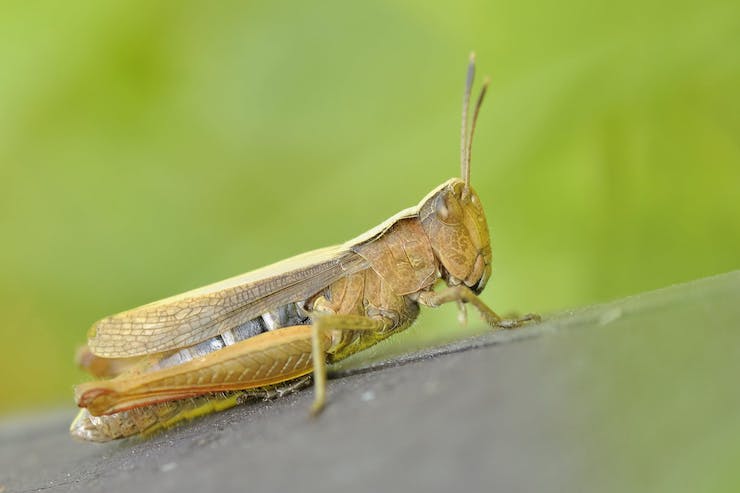The United Nations Food and Agriculture Organization (FAO) to Start Using Drones Against the Locust Infestation in Africa

When the ten plagues descended upon Egypt, the eighth plague was locust. In modern times, people often image these locust as simple grasshoppers, not actually grasping just how damaging they can be. Desert locust may look like common grasshoppers, but they are one of the most devastating pests in the world. A swarm of locust can be made up of 150 million of the crop killers per one square kilometer. These insects travel far and fast with the wind, up to 150 km a day. In one day the swarm can consume enough food to feed 35,000 people. In parts of the world already struggling to keep people fed, a swarm of locust can truly feel like a plague.
This past year parts of Africa have seen the worst desert locust invasion that continent has faced in decades. The swarms have already passed through Ethiopia, Somalia, Kenya, Uganda, Eritrea, and Djibouti. One of the swarms has been measured to be between 40-60 km large, destroying tens of thousands of hectares of crops for human and livestock consumption. The United Nations Food and Agriculture Organization (FAO) is fearful that if the situation is not taken into control soon, the swarms can grow up to 500 times in size and migrate into South Sudan.
The FAO is looking to modern technology to combat these ancient pests, drones. Part of the problem with keeping up with the swarm’s migration is simply tracking the swarm’s current position, and it’s projected path. For years the FAO has been monitoring desert locust outbreaks over the vast lands of Africa. However, many of these surveying ground units can be days away from a reporting center when they spot an outbreak, with no mobile or internet connection. In a paper published by the FAO they explain, “Although satellite-based estimates of rainfall and green vegetation can guide monitoring routes, images suffer from omission errors and are often not available in time. Aerial surveys are often precluded by high costs or unavailability of aircraft. There is a need to supplement these tools with technologies to guide ground teams to green vegetation and locust infestations.” Drones have the ability to gather critical data needed to map how a swarm will move.
Because drones are inexpensive and fast they can cover wide areas of land in short amounts of time, at a fraction of the cost of using a helicopter or plane. The drones can supply a visual confirmation of wild vegetation that will attract a swarm of locust, helping determine the direction a swarm will travel in. The drones can also be used to locate and follow a swarm. Once these measures are in place, actions to control the swarm can be taken. One such measure would be to use a different drone to spray the locusts with pesticides. Drones have been used all over the world to spray crops for pests to great success, but never to this magnitude. Keith Cressman, senior locust forecasting officer at FAO is in charge of orchestrating a trial to use drones against the desert locusts. “Nobody’s ever done this with desert locusts before. So we have no proven methodology for using drones for spraying on locusts,” said Cressman. “There are already small atomizer sprayers made for drones. But with locusts, we just don’t know how high and how fast to fly.”
The action plan outlined in the paper put out by the FAO explains, “The drone would be capable of flying some 100 km while collecting data on the location of green vegetation and processing this imagery on board as a map. In turn, the map would guide ground survey teams to areas for further inspection of up to 5 km using a rotary drone. If significant infestations were found, then a control drone could safely and effectively spray the locusts before they form swarms.” But before any of this can commence, the dLocust drones FAO plans to use must overcome several logistical issues.
There are restrictions as to the amount of chemicals a drone can carry, which may not be enough volume to treat an area. There is also the concern of flight ease and safety, as well as battery life. The FAO article further states, “All the drones would have to be lightweight, portable, solar powered, durable and easy to use and maintain locally. The ‘dLocust family’ would be integrated with eLocust3, the hand-held rugged tablet used by survey and control teams for recording observations and transmitting them in real-time by satellite. National locust centres would be responsible for managing and using dLocust.”
While there has been no research or trials testing drones in locust management, drones have been critical tools in the field of agriculture. They are able to collect data, monitor crops and herds, apply chemical treatments, and much more. There is little reason to suspect the dLocust drones would be any less successful. These drones could help the FAO protect regions from current and future locust infestations. They can also help gather data to be used in restoration after a swarm has devastated land. As the FAO states as it’s ultimate goal, “In a few years’ time, the integration of dLocust with current survey activities undertaken by national teams on the ground will enhance the efficiency and timeliness of Desert Locust monitoring and early warning, leading to a decline in frequency, duration and intensity of devastating plagues, and improving food security and livelihoods.”
|